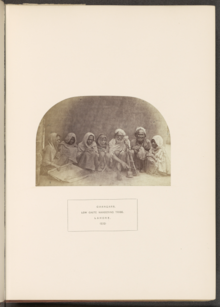| Revision as of 22:08, 21 October 2023 editSitush (talk | contribs)Autopatrolled, Extended confirmed users, Page movers, File movers, Pending changes reviewers, Rollbackers260,192 edits →top: WP:INDICSCRIPTTags: Mobile edit Mobile app edit Android app edit← Previous edit | Revision as of 22:09, 21 October 2023 edit undoSitush (talk | contribs)Autopatrolled, Extended confirmed users, Page movers, File movers, Pending changes reviewers, Rollbackers260,192 edits →Origin: not reliable - see WP:RAJTags: Mobile edit Mobile app edit Android app editNext edit → | ||
| Line 9: | Line 9: | ||
| == Origin == | == Origin == | ||
| According to Indian and Pakistani |
According to Indian and Pakistani scholars, they are remnants of the ] and ], who intermingled with ], some of them left India at the time of ] and went in different ways to Europe, under the Hindu caste system, they are considered as ]<ref>https://romahistory.romaedu.org/indogriechen/</ref> | ||
| Under Mughal Empire, the Changar became Muslims, but their religion is a mix of Hinduism and Islam. | |||
| == Present circumstances == | == Present circumstances == | ||
Revision as of 22:09, 21 October 2023
| This article uses bare URLs, which are uninformative and vulnerable to link rot. Please consider converting them to full citations to ensure the article remains verifiable and maintains a consistent citation style. Several templates and tools are available to assist in formatting, such as reFill (documentation) and Citation bot (documentation). (August 2022) (Learn how and when to remove this message) |

Changar or Chingar are an ancient mysterious vagabond former Hindu tribe of India.
Changars sometimes called Cingân, Tsingan, Chingari, Tsingari, Tschangar etc., are mostly vagabond and speak their own Changhri dialect. According to Johann Galletti and Franz Miklosich and some other early European historians, the Romani People of Europe are closely related to the Changar (German: Tschangar) and are Tschandala.
Origin
According to Indian and Pakistani scholars, they are remnants of the Indo-Greeks and Greco-Bactrians, who intermingled with Jats, some of them left India at the time of Migration period and went in different ways to Europe, under the Hindu caste system, they are considered as Chandala
Present circumstances
The Roma people are descendants more or less of the Changar from Pakistan, as genetic Study shows. Some Changars left Sindh through Egypt in Migration period, and later lived in Anatolia and called in Greek language Athinganoi
In India
The Changar are largely a landless community, with a few still involved in their traditionally occupation of lime manufacture. Most are now daily wage labourers. Like other Rajasthani Muslims, the community has a caste association or biradari panchayat, which resolves intra community disputes and enforces communal norms. Although the Changhar live in close proximity to other such Muslim castes such as the Hiranbaz, Sindhi-Sipahi and Qaimkhani, intermarriages between them and the Changar are extremely rare. The Changhar are Sunni Muslims, and their customs are similar to other Rajasthani Muslims. They have been granted Other Backward Class status, which makes them subject to a number of affirmative actions policies of the Government of India.
In Pakistan
The Shamsi (Changar) in Punjab are strictly endogamous, and the basic social unit is the Jhugi or tent (now new generations are mostly educated and have their own houses). Generally it is close kin who camp together, and marriages are preferred within the encampment. They do not have strong caste councils to maintain community norms. Most of the Shamsi called Changar in Pakistan migrated from Indian Jalindher's Tehsil Sultan Poor and District Ludhiana. They spread in all Pakistan. Mostly settled in Chiniot and Faisalabad District. The Changar are Sunni Muslims and either speak Haryanvi Punjabi or Seraiki depending on what language the settled community in which they are camped speaks (Although they speak Parsi language called by one of the old Changar). They speak this language as secret language when they inform some thing secret which each other.
The majority of the Changars within northern and central Punjab are agricultural labourers, visiting villages during harvest time. They have established routes that they follow, and each Changar sub-group is allocated a particular village, and often serve a particular family in that village. Their patrons tend to belong to the large Muslim Jat community. In addition to agricultural labour, the Changar are also involved in the manufacture of baskets and brooms, which they sell to settled communities. Nowadays only 10% are involving in this work. Many of Shamsi (Changar) are now in good Jobs and local business after getting education. In local Government they have their own Counselors and have Chairmanship. In 1990 many of Shamsi moved toward Dubai for better future, they earn for his family and country now getting part of i community progress.
References
- https://romahistory.romaedu.org/indogriechen/
- "HYDERABAD: Gypsies hail from Sindh, claims Dr Kazi". 25 September 2006.
- https://mdpi-res.com/d_attachment/genes/genes-13-00532/article_deploy/genes-13-00532-v2.pdf?version=1647586726
- Cite error: The named reference
People of Indiawas invoked but never defined (see the help page). - Servicing the Ordinary Folk: Peripatetic People and their Niche in South Asia by Joseph C Berland in Nomadism in South Asia Edited by Aparna Rao and Michael J Casimir